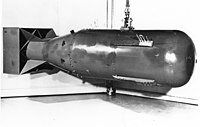
Photo from wikipedia
Abstract Wildfire is a critical process shaping the structure and composition of forest landscapes of western Canada. Spatially-explicit forest disturbance history and forest structure estimated using remotely-sensed data enables the… Click to show full abstract
Abstract Wildfire is a critical process shaping the structure and composition of forest landscapes of western Canada. Spatially-explicit forest disturbance history and forest structure estimated using remotely-sensed data enables the characterization of burn probability, defined as the susceptibility of landscapes to fire hazard over time. In this research, we leveraged the Landsat archive to determine the capacity of land cover, forest structure, and forest disturbance information, together with ancillary data, to estimate burn probability. We analyzed the interactions between a number of contributing factors and identified landscapes with high probability to burn across forested ecosystems of Saskatchewan, Canada. Overall, we found that forests composed of coniferous species, with shorter trees (<3 m), low canopy height variability, an open stand structure (<10% canopy cover), and low timber volumes (<50 m3/ha), had higher burn probabilities. A 2015 burn probability map indicated that forests that did burn in 2015 (determined using independently mapped wildfires) had a median predicted burn probability of 81%, while the median burn probability for unburned forest area was 19%. This paper demonstrates the potential to generate detailed and spatially-explicit burn probability maps from time series remote sensing data to inform wildland fire risk modeling, management, and mitigation.
Journal Title: Canadian Journal of Remote Sensing
Year Published: 2020
Link to full text (if available)
Share on Social Media: Sign Up to like & get
recommendations!